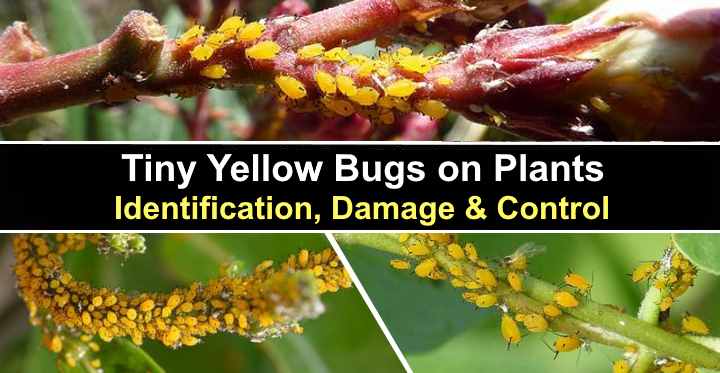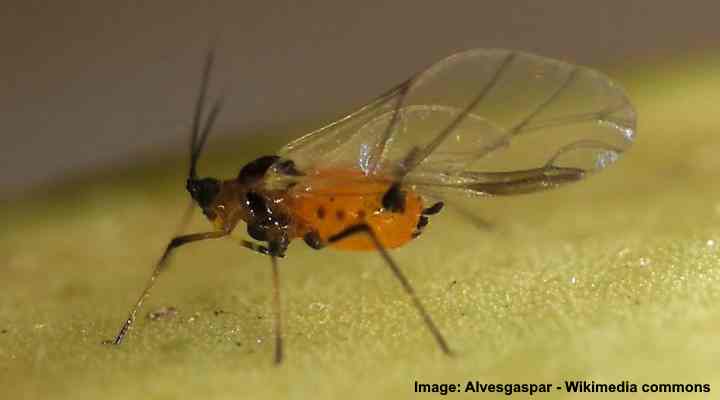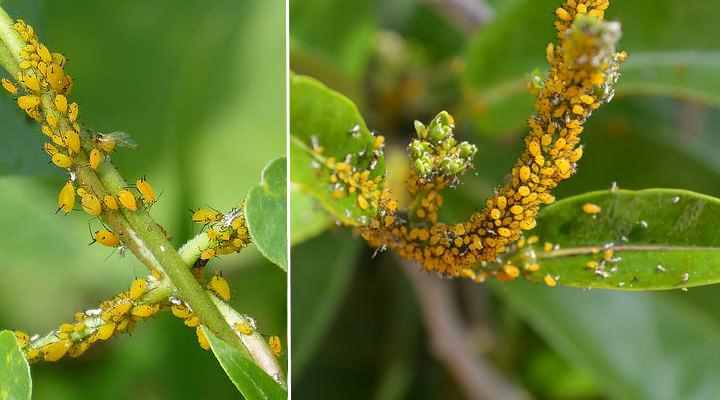Tiny Yellow Bugs on Plants: Identification, Damage & Control

Tiny yellow bugs crawling on the leaves or stems of your houseplants can send you into a panic. The small mite-like creatures look like little bright-yellow pear-shaped bugs with black legs and two dark antennae. Unfortunately, these tiny yellowish and black bugs are more than a nuisance pest. These bugs are yellow aphids—a type of sap-sucking insect that kills houseplants, greenhouse plants, and outdoor ornamental plants.
What should you do if you notice masses of tiny yellow bugs with black legs crawling over your prized houseplants? How can you get rid of yellow-colored aphids for good? This article helps you identify yellow plant bugs and provides handy tips on how to eradicate them.
What Are Yellow Bugs on Plants?

Yellow aphids (Aphis nerii) have spread from the Mediterranean region and are found in many places, particularly tropical and subtropical regions
Yellow bugs on houseplants, crops, and ornamental shrubs are yellow aphids (Aphis nerii). The soft-bodied yellow creatures are also called oleander aphids, sweet pepper aphids, and milkweed aphids. The tiny creatures suck juices from plant tissue and spread plant diseases when the yellow bugs bite into the leaves and stems.
Related reading: How to identify black aphids.
What Do Yellow Bugs (Aphis nerii) Look Like?

A close up picture of yellow aphid
Yellow bugs on plants are recognizable by their pear-shaped lemon-yellow bodies, long black legs, dark antennae, and two tiny black tubes at their rear (cornicles). The small bugs have long slender mouthparts they use to pierce and suck plant juices from leaves, stems, and other tender plant parts. Some yellow aphids may have a woolly appearance.
Another feature of adult yellow bugs is that the females have black wings. These, together with the black legs and antennae, give the aphids a yellow and black appearance. The winged bugs often fly to other plants when the colony becomes too large.

Winged female Aphis nerii
Tiny yellow bugs measure between 0.06” to 0.1” (1.5 – 2.6 mm) long. Although the minuscule yellow bugs are easier to spot when they congregate on plant leaves and stems, their bright yellow appearance makes yellow aphids relatively easy to spot.
Yellow aphid nymphs look like the adults. The almost microscopic pear-shaped yellow bugs also have identifiable black legs, antennae, and cornicles. However, they appear as tiny yellow dots on leaves, and you may need a magnifying lens to see them.
Yellow Aphid Life Cycle

A female yellow aphid giving birth to live nymph
The life cycle of a yellow aphid starts when the female gives birth to live nymphs, not eggs. The tiny yellow immature bugs go through five nymphal instars. Each time they molt and shed their skin as they grow and become adults. Female aphids can deposit up to 12 nymphs per day.
Some species of yellow bugs mate and produce eggs in fall or winter. The bugs may deposit these eggs on perennial plants to overwinter and hatch the following spring. In exceptionally warm weather, a nymph yellow aphid can mature in eight days and produce up to 80 offspring a week.
The yellow bug’s ability to reproduce so quickly is why it quickly becomes a pest.
Where Do Yellow Bugs Come From?

Plants infested with yellow aphids
Yellow bugs come from their winter hideaways, where they overwinter on the undersides of leaves or in tree bark crevices. Yellow bugs also get into homes on infested houseplants or in soil contaminated with the yellow bug eggs. Also, the bright yellow pests can fly in through open windows.
In warm, southern gardens, aphids usually fly from neighboring plants or trees or are carried by the wind.
Because yellow bugs can easily hitch a ride on houseplants, it’s a good idea to thoroughly inspect new plants for signs of aphids or bug damage. You should look for tiny yellow mites crawling under leaves or whitish eggs the size of pinpricks.
Additionally, it’s always good practice to repot newly purchased houseplants to ensure the soil isn’t contaminated with yellow aphid eggs or nymphs. Finally, remember to dispose of old soil so that it doesn’t contaminate other plants in your home or yard.
How to Identify Yellow Bugs (Yellow Aphids) on Plants
You can identify yellow bugs on plants in two ways—signs of the yellow, pear-shaped bugs on leaves or plant damage. Look under leaves to see if tiny yellow bugs are crawling around. Also, yellow bugs will cause plant leaves to appear curled or misshapen, and they may leave behind honeydew.
Identifying a few yellow aphids on plants is challenging. You will need to take a magnifying lens to look for the following identifiable bug features:
- Bright lemon-yellow pear-shaped bugs with long black legs
- Two conspicuous antennae at their head and two black cornicles at their rear
- Many adult yellow aphids have recognizable black wings
The other identifying feature of yellow bugs—and the easiest to spot—is plant damage. If you notice plants with deformed leaves that are curled or slow plant growth, you should inspect the foliage for yellow bugs. Additionally, honeydew—a sticky, amber-colored substance—is often a sign of aphid activity.
Signs of Yellow Bug Plant Damage
Plant damage caused by yellow bugs includes yellowing leaves, stunted shoots, and sticky honeydew. This may also result in sooty mold fungus on leaves. Additionally, yellow bug plant damage could result in leaves that curl and become distorted. However, yellow aphids rarely permanently damage plants or shrubs in low numbers.
Large numbers of the tiny yellow bugs can severely affect a plant’s health. The nasty sap-sucking yellow insects can weaken the plant, making it susceptible to stress and diseases. The bugs suck the plant’s juices, starving it of vital nutrients. Additionally, aphids can transmit several viruses when they attack ornamental plants.
How to Get Rid of Yellow Bugs on Plants
Getting rid of yellow bugs on plants requires a multi-method approach. Eradicating yellow plant bugs starts by physically removing as many pests as possible. Then you can use natural plant bug sprays like neem oil to kill the remaining insects, including their eggs and larvae.
Eliminate Yellow Bugs Using Water Pressure
A strong spray of water will dislodge most yellow bugs from plant foliage and stems. The bug eradication method is effective for indoor and outdoor plants.
For example, take an infested house plant to the shower and use a strong spray of water to rinse the bugs from the plant. The pesky yellow critters will disappear down the drain and be gone for good. At the same time, you also hydrate the plant’s foliage which encourages good health.
To get rid of aphids on outdoor plants, use your garden hose to blast the aphids with water. The strong spray should be powerful enough to displace the bugs but not enough to damage leaves. Also, remember to spray water on the underside of leaves to remove all aphids.
Top tip for getting rid of yellow bugs from garden plants: Use the water spray method early in the day to give foliage plenty of time to dry and avoid fungal diseases.
Use a Neem Oil Spray to Kill Yellow Bugs on Plants
Spraying infected plants with neem oil is effective for eliminating tiny yellow bugs. To make an effective spray to control an aphid infestation, mix 2 tsp. neem oil and 1 tsp. Castile soap with 1 quart (1 l) of lukewarm water. Put the solution in a spray bottle and thoroughly spray your plant’s foliage.
The best way to use neem oil to kill yellow bugs for good is to apply the pest spray every seven days.
Neem oil is a natural, organic insecticide that kills yellow aphids and other houseplant bugs. The natural substance contains the active ingredient azadirachtin, which acts as an insect repellent and disrupts their reproductive system. This bug solution helps to kill yellow bugs and reduce their population.
Scientific studies suggest that spraying plants with neem oil can help eradicate yellow aphids to prevent plant damage. One study found that aphids tend to avoid feeding on plants sprayed with a neem oil solution. In addition, the neem oil spray has a lethal effect on Aphis nerii.
Insecticidal Soap to Eradicate Yellow Bugs on Houseplants
Use an insecticidal soap spray to kill yellow bugs for good. To make a bug-busting spray, combine 1 tbsp. liquid Castile soap and 1 tbsp. vegetable oil with half a gallon (2.3 l) of distilled water. Put in a large container and shake well to combine the liquids.
Using a garden pump sprayer or a handheld spray bottle, thoroughly douse the infested plant’s foliage with the soapy solution. The bug spray works because the fatty acids break down the soft bodies of the yellow pests, killing them for good.
Alternatively, you can buy a natural insecticidal soap made from organic ingredients. This way, you protect the plant’s health and destroy the nasty plant-destroying bugs simultaneously.
Apply Rubbing Alcohol to Kill Yellow Aphids Instantly
To kill yellow bugs on contact, use 70% rubbing alcohol to zap aphids instantly. To control an aphid population, make an alcohol bug spray by combining a cup of isopropyl alcohol with 1 quart (1 l) of water. Then, spray the solution on yellow bugs on your plants.
For best results, spray plants weekly with the alcohol solution to eliminate yellow aphids and other houseplant bugs.
An alcohol bug spray is also effective against aphid eggs that overwinter on plant foliage. To prevent an outbreak of yellow bugs in the spring, soak a cloth in the alcohol-water solution. Then, wipe down both sides of leaves and around stems to kill any microscopic aphid eggs that may be lurking.
Sprinkle Diatomaceous Earth to Kill Yellow Pests on Plants
Non-toxic diatomaceous earth (DE) is an effective and safe method to destroy plant-sucking yellow aphids. To use DE as a lethal bug solution, dust plant foliage with the white powder. The abrasive substance dissolves the waxy coating on their bodies, causing the pests to dehydrate and die.
There are a few precautions to remember when using diatomaceous earth for killing bugs. Here they are:
- Diatomaceous earth is only effective on dry plant foliage and soil.
- Reapply to indoor and outdoor plants if they were wet.
- Although it’s not harmful to humans, DE is a fine dust, and you should wear a face mask and eye protection when handling it.
- Diatomaceous is useful for controlling many types of bugs like fleas, bed bugs, cockroaches, and caterpillars.
Control Yellow Bugs Indoors Using Sticky Traps
Get rid of yellow aphids from your plants by using sticky yellow or blue traps. These sticky traps will catch a wide range of flying plant pests, not just pesky flying yellow aphids. Although sticky traps won’t eradicate yellow flying bugs entirely, they can significantly reduce their numbers.
Introduce Beneficial Insects for Yellow Bug Control
Are yellow bugs running amok on crops, shrubs, and trees in your greenhouse or garden? If that is so, introducing beneficial insects can help get rid of aphids naturally. Natural predatory aphid enemies hunt down and kill the plant-destroying bugs so they no longer threaten plant health.
The best beneficial insects to encourage in your backyard or greenhouse are parasitic wasps. These flying creatures lay eggs inside aphids, killing the nasty yellow bugs from the inside. You know when the parasitic wasps are effective when you begin to see mummified aphids on plants.
Other types of beneficial insects you can use to control aphids include the following:
- Ladybugs
- Soldier beetles
- Lacewings
- Syrphid flies
How to Prevent Yellow Bugs on Plants
It’s challenging to prevent small yellow bugs from infesting houseplants or outdoor plants. The best bug prevention methods are to grow healthy plants that are resistant to all kinds of plant pests, including yellow aphids. Also, watering plants properly and applying the right fertilizer keep plants healthy and pest-resistant.
Here are some helpful tips on preventing an infestation of yellow bugs on plants:
Inspect new houseplants for bugs
Always inspect houseplants when you bring them into the home, whether they are from a garden center or your patio. Plants outdoors are susceptible to bug infestation. The favorite hiding place for pesky yellow bugs is under leaves. So, inspect those areas with a magnifying lens before bringing them inside.
Wipe plant foliage
A good plant bug prevention technique is to wipe down foliage with an alcohol solution. This simple yet effective method kills any aphid eggs stuck to plant leaves. You will then prevent yellow aphids from hatching in spring.
Get rid of ants from the garden
Eradicating ants from garden plants is vital in controlling yellow aphids. Ants protect aphids from predators as they feed on the honeydew secreted by the aphids. This can make it impossible to get rid of aphids using beneficial predatory insects. So, to increase the chances of eradicating yellow bugs, get rid of the ants as well.
Related reading: Ants in the garden – good or bad?
Avoid overfertilization to prevent yellow bugs on garden plants
To avoid attracting aphids to your ornamental garden shrubs, always apply the right amounts of fertilizer. High levels of nitrogen in the soil encourage aphid reproduction. The best way to fertilize your garden plants is to use slow-release or organic fertilizers.
Use reflective mulch covers to prevent yellow bugs on outdoor plants
To avoid an outbreak of yellow aphids in spring, put a layer of reflective mulch cover around crops and ornamental shrubs. According to some studies, reflective mulches repel aphids and help protect crops from infestation and aphid-borne diseases.
Avoid using broad-spectrum pesticides on outdoor plants
Suppose you want to prevent yellow bugs in your garden. In that case, it’s best to avoid broad-spectrum pesticides because they also kill beneficial predatory insects.
Related articles:
